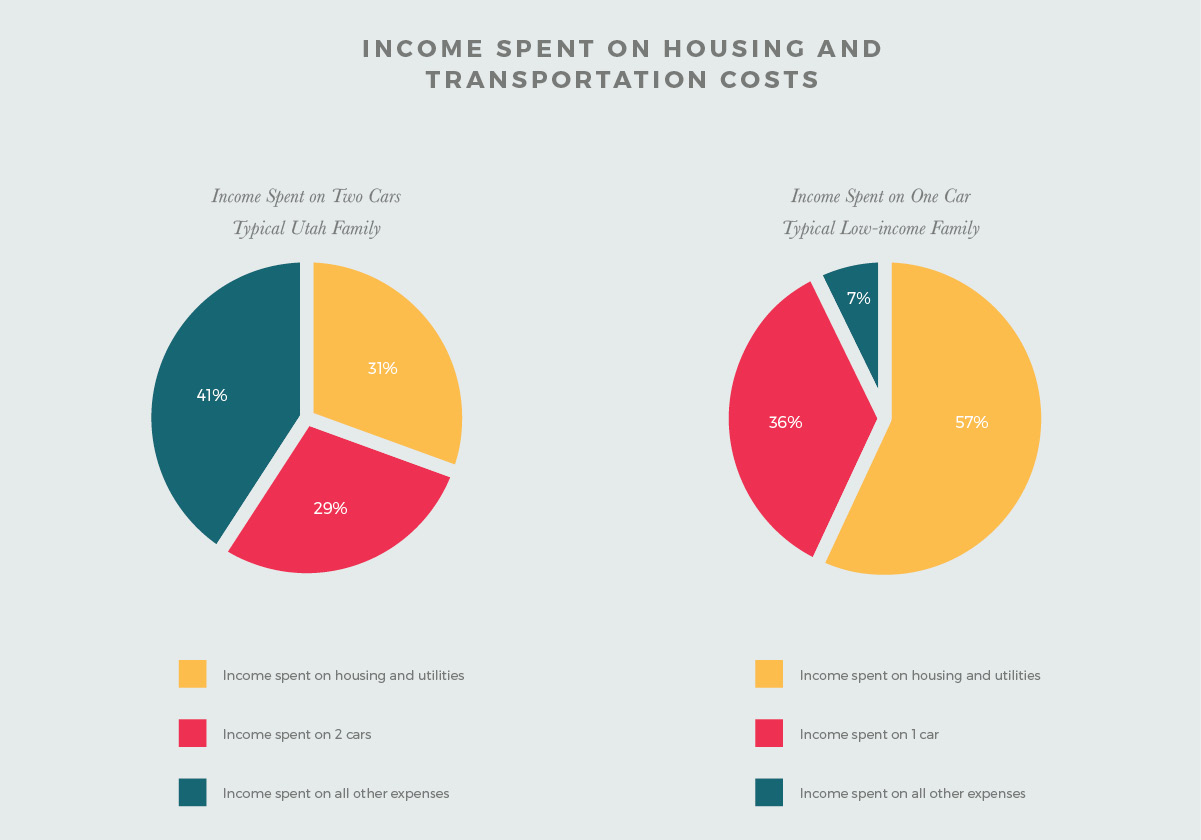Background:
Being able to provide for their families with a sense of financial security is critical to Utahns’ quality of life. A lower cost of living helps Utah families make ends meet with less stress and fewer working hours, so they can spend more time together doing things they enjoy. When Utah families can afford good homes in good neighborhoods, they can also break the cycle of poverty, make their homes and neighborhoods attractive, and contribute to their communities. This makes better, safer communities.
Housing is the largest expenditure in a typical household budget, and as land prices continue to increase near job centers, housing costs will only increase. Transportation costs also eat up nearly one third of the typical Utah household budget. These costs include car payments, insurance, gas, repairs, and more. Utahns want a variety of housing and transportation options in safe neighborhoods, with good access to jobs, shopping, schools, and other services and amenities. These housing and transportation options will allow Utahns to provide a high quality of life for themselves and their families, all without straining their budgets.
A low cost of living allows Utahns to save more money and worry less about providing for their families and about whether their children will need to leave Utah to find a place they can afford. Employers are also attracted to Utah by comparatively low housing and other costs.
HOUSING COSTS
Providing a variety of housing options in all communities helps ensure that everyone has a decent, affordable place to live. Factors such as housing supply, market demand, and cost of infrastructure affect how affordable housing is for Utahns.
To keep housing affordable, the supply of housing types must match what Utahns want and can afford. For example, if Utahns desire or need to live in townhomes, apartments, or condominiums, and those housing types are in short supply in desirable neighborhoods, the cost of those types of housing will unnecessarily increase. Having a variety of housing options will also allow Utahns to remain in their communities as their family sizes, incomes, job locations, or other circumstances change.
When housing markets are allowed to work, almost everyone can find a place to live. It is important that zoning regulations do not prevent the market from supplying the housing that is needed.
For decades, the housing market in Utah has been shifting to fewer large-lot homes and more compact housing such as small-lot homes, townhomes, condominiums, and appartments. This is mainly due to rising land prices near job centers and shifting housing preferences.
This market shift provides an opportunity to reduce infrastructure costs because when homes are closer together, roads, pipes, and other infrastructure don’t have to stretch as far and don’t cost as much per home. Increased costs for building and maintaining local infrastructure like roads and pipes raise the price of housing because these expenses are typically passed on to homebuyers and renters through taxes, increased utility fees, and higher home prices.
Another major market trend is a result of online shopping. Because many purchases do not come from a store, the amount of retail store space per person is declining and is predicted to dramatically decrease in the future. Many buildings in today’s shopping centers will become available for other uses or will be replaced by different types of buildings. These retail areas can be converted into mixed-use centers, with compact housing, restaurants, and other local services. Not only do mixed-use centers revitalize old shopping centers and allow cities to combat declining sales tax revenues, but they also provide Utahns with convenient access to jobs, shopping, recreation, public transportation, and other uses.
TRANSPORTATION COSTS
Transportation costs make up nearly a third of a typical family’s budget in Utah. These costs are largely determined by how close housing is to jobs and daily needs, by the availability of good public transportation, and by the convenience and safety of other transportation options, like biking or walking. If Utahns can reach work, school, shopping, and other destinations without driving or by driving shorter distances, they can drive less or even own fewer or no cars. This saves money on car payments, fuel, insurance, and maintenance.



